How To Fish San Luis Reservoir
San Luis Reservoir Fishing Report
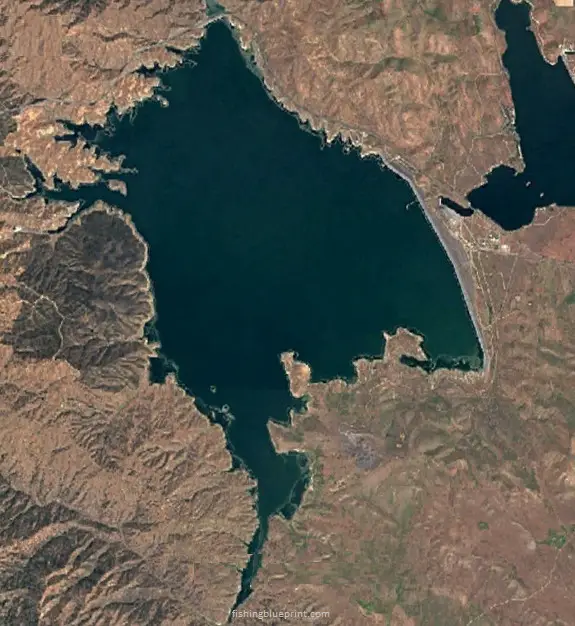
San Luis Reservoir is a large lake that sits 120 miles away from San Francisco, or 276 miles from Los Angeles.
Overall it’s a popular weekend getaway lake known for its fantastic striped bass and largemouth bass fishing. You can also catch catfish and crappie fishing during the summer. Conversely, you can catch trout, salmon and sturgeon fishing during the winter. In this post you’re going to be given the blueprint to fish this lake.
So what are the best tips for fishing San Luis Reservoir? There are three important factors you must know if you want to know how to fish San Luis Reservoir successfully. First, you need to know what kind of fish is in San Luis Reservoir. Second, it’s important for you to know which part of the lake each species can be found. Lastly, knowing what are the best baits that work on San Luis Reservoir is vital. However, tactics, baits, and locations will be different for each type of fish that you target. So let’s talk about the steps you need to take in order to give you the best chance of catching a fish on San Luis Reservoir.
About San Luis Reservoir
San Luis Reservoir is a moderately deep body of water with the average depth being 130 feet and a maximum depth of 270 feet when the lake is completely full. Being 9 miles long and 5 miles across, fishing at San Luis Reservoir can be gangbusters when you have over 12,700 acres to fish!
Important Lake Warnings
Algae blooms may be present which may affect fishing, swimming, and water contact in general.
According to parks.ca.gov, “every one of California’s new laws requires boat operators to have a California Boating Card. The card is required for anyone under the age of 41 to operate a boat in California’s waters.”
If you are fishing and camping, fire bans may be in effect due to the ongoing drought conditions.
San Luis Reservoir Fishing Tips & General Strategies
It can be a challenge to break down San Luis Reservoir and decide to get started… that’s why I wrote this San Luis Reservoir fishing report!
Water Clarity:
In my first trip to San Luis Reservoir, I found the water clarity to be fair to decent/lightly stained. This clarity allowed me to spot my submerged targets with a good pair of sunglasses. However, the buddy I was with told me weather conditions change pretty quick which also affects water clarity, so to always come prepared for both clear and stained conditions.
Structures and Fishing Cover:
At San Luis Reservoir, I discovered some cool structures and cover that gave me a chance to reel in some serious striped bass. Here’s what I experienced:
Deeper Waters: Striped bass loved hangin’ out between 50 to 90 feet deep.
- I was taught to focus on the drop-offs, channels, points, and submerged humps.
- Along with that, we also fished chunk rock ranging from baseball to basketball size, which attracted other predatory fish like bass, crappie, and catfish.
Feeder Creeks & Bays: These areas were bass-ically a largemouth bass paradise.
- Fishing vegetation is my thing… I love it. Back in the creeks were thick with weeds and submerged vegetation, these spots were prime real estate for me to target.
- I was told several of the small creek inlets and cuts go off during the spring spawning season.
Rocky Structures: The majority of the bass spawn in 1 to 15 feet of water here, notably on rocky structures and gravel flats.
- These areas provided a safe haven for their prey, making it a bass buffet for me to explore.
Wind Warning: High winds and breezy conditions were common, so I kept an eye on those strategically placed wind warning lights and alarms.
- I had to adjust my casting angles and use different tactics, such as using heavier baits, to combat those windy days.
Springtime Fishing update
Air temperature
You should expect a variety of weather patterns at San Luis Reservoir in the spring. The mid-50s to mid-70s (°F) air temperature range often provides nice fishing conditions. Yet, given that temperatures can change during the season, it is imperative to be ready for alterations.
Weather
The weather patterns at the reservoir are hugely affected by wind speed and direction. Winds usually blow from the northwest and are generally strong and windy. There can be a range in wind speeds, with some days being calm and others having gusts of up to 25 mph or more. It’s important to pay attention to the carefully positioned wind warning lights and sirens surrounding the reservoir because they warn fishermen to take cover before strong winds cause hazardous boating and fishing conditions.
Both striped bass and largemouth bass have different spawning seasons at San Luis Reservoir, and each species has distinct requirements. Below is a list of the times and locations where these fish are likely to spawn, along with the expected water temperatures.
Striped Bass
Peak activity for spawning occurs between late April and early June. Striped bass normally spawn in the late spring and early summer.
Between 60°F and 70°F is the ideal water temp for striped bass spawning, and will prefer areas with good current, such as the reservoir’s main body, or near the dam.
Largemouth Bass
Peak activity for largemouth bass spawning usually happens between late March and early May.
Between 55°F and 65°F is the best water temperature for largemouth bass to spawn.
Largemouth bass can be found spawning in feeder creeks, bays, weedy spots, and submerged vegetation in San Luis Reservoir.
In shallow waterways between one and fifteen feet deep, largemouth bass typically lay their eggs, especially on rocky outcrops, gravel flats, and small creek inlets and cuts.
Summer Fishing update
At San Luis Reservoir, summer weather patterns can be unpredictable and include fluctuations in air temperature, wind speed, and wind direction.
Air Temperature
The San Luis Reservoir experiences summertime temperatures that have been reaching highs of 80 to low 90 degrees Fahrenheit (°F) during the day and lows of 50 to 60 degrees Fahrenheit (°F) at night.
Wind Direction and Speed
The reservoir’s weather patterns depend heavily on the strength and direction of the wind. These hot days have been frequently windy and gusty, with winds frequently coming from the northwest.
Similar to the spring, there can be a wide range in wind speeds, with some days being calm and others having gusts of up to 25 mph or more.
Water temperature on average
The normal range of the water temperature in San Luis Reservoir has been averaging between 70°F and 80°F.
Striped bass and largemouth bass’s main food source
Throughout the summer, threadfin shad, which are plentiful in the reservoir, serve as the principal food source for striped bass and largemouth bass in San Luis Reservoir.
When shad are close to the surface in the early morning, striped bass frequently become more active. Striped bass will go into deeper water as the day goes on and keep feeding. You’ll have the best luck catching deep striped bass if you’re trolling live bait, however artificial lures can work really well too.
The main food sources for largemouth bass include shad, crayfish, and smaller fish like bluegill. To escape the heat in the summer, largemouth bass will travel to deeper water (about 15 to 30 feet deep). For the greatest chance of catching largemouth bass, concentrate on drop-offs, channels, points, and submerged humps. These fish may also be drawn to the presence of boulders of rock that range in size from a baseball to a basketball because they offer a secure hiding place for their prey.
Best Techniques for Summer Bass Fishing
- Deep-diving crankbaits: Target deep water structure, like drop-offs and submerged humps, where bass seek cooler water.
- Carolina or Texas rig soft plastics: Slowly work these rigs around submerged vegetation and rocky structures to entice bass.
- Jigs: Use jigs around deep cover, such as rocks or submerged trees, to mimic crayfish and other bass prey.
Reaction Style Baits
- Strike King 6XD: A deep-diving crankbait for targeting bass in deeper waters.
- Bill Lewis Rat-L-Trap: A lipless crankbait that can be effective when fished around submerged vegetation.
- River2Sea Whopper Plopper: A topwater lure that creates a lot of commotion, attracting bass from a distance.
Finesse Style Baits
- Gary Yamamoto Senko: A versatile soft plastic bait that can be rigged in various ways.
- Zoom Brush Hog: A creature bait that entices bass when fished slowly around cover.
- Roboworm Straight Tail Worm: A finesse worm ideal for drop-shot rigging in deeper water.
Specific Locations for Summer Bass Fishing
- Romero Visitor Center area: Provides access to deeper water where bass tend to congregate during the summer.
- Dinosaur Point: Offers access to submerged structure and ledges where bass may be hiding.
- Basalt Campground: A location with rocky structure and drop-offs, providing ideal bass habitat.
- Portuguese Cove: Known for its underwater vegetation and potential to hold largemouth bass.
Other than bass, the San Luis Reservoir is home to a variety of game fish. These species include, among others:
Crappie: This fish can be found along docks, brush piles, and submerged structures. It may be successful to use tiny jigs or live minnows suspended beneath a bobber. When crappie are most active, concentrate on fishing around dawn and dusk.
Bluegill: These little guys can be caught using small live baits like worms or crickets, or artificial lures like small jigs or spinnerbaits. Bluegill are frequently found in shallow water near vegetation or other cover. The best spinning rod for spotting bluegill bites has a super flexible tip.
Catfish: The San Luis Reservoir is home to channel catfish and other catfish species. Cut bait, stink bait, nightcrawlers, or live minnows are some examples of the baits that can be used to catch these bottom-dwelling species. In deeper water or close to submerged structure, fish near the bottom during the daytime, and at night, try shallow spots close to the shore.
Trout: Although less frequent than other species in the lake, trout are nonetheless catchable. Live bait like nightcrawlers or power bait can work when fishing from the shore. However if you’re trolling, trout can be caught using small spoons, spinners, or flies. Fish in shallower water during colder months and deeper water during the hottest months.
But Where Are The Best Places To Fish At San Luis Reservoir?
And in no particular order here is that list of the best fishing spots at San Luis Reservoir.
DISCLAIMER: The material provided is for general information purposes only. It’s important to understand that any information provided in this article can change at any time. Any maps or graphics featured are not to be used as navigational aids. Fishing Blueprint will not be responsible for any personal injury or property damage from any misuse of the maps or graphics provided. It’s completely impossible to give you every single spot where you can potentially catch a fish. But, what this list does do is to give you a helping hand and narrow down to the most productive fishing spots.
Dinosaur Point
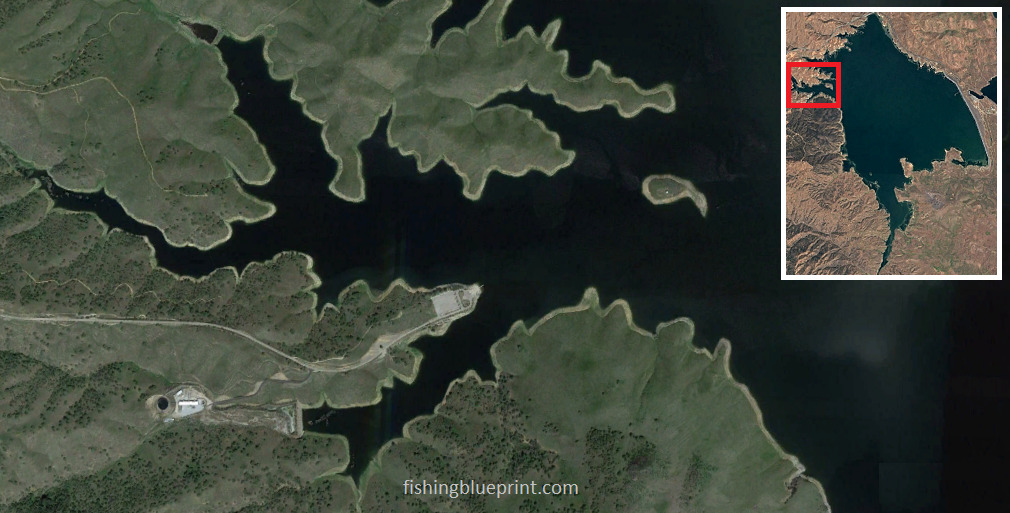
This is a moderately-sized open bay that I enjoy fishing that has several smaller creek ditches that drained into multiple larger, submerged creek channels. This bay offered many different structures to target and fish.
The main creek channels that drained from the bay to the main lake created underwater main lake points. I scanned these areas, as they often had rocky high spots, ridges, humps, and ledges associated with them.
Moving further into the bay, I made sure to scan the ditch and channel interactions. This area also had rocky high spots, ridges, humps, and ledges, along with channel swings that held fish.
Lastly, in times of high water conditions, I found submerged trees and brush in the back of the feeder creeks. These spots proved to be productive areas to fish as well.
Located: northwest lake
Structural features: creek channels, chunk rock bank submerged trees and brush
Best species to target: Striped bass, largemouth bass, catfish, crappie
Most effective way to fish this spot: boat, kayak, shore fishing
Honker Bay
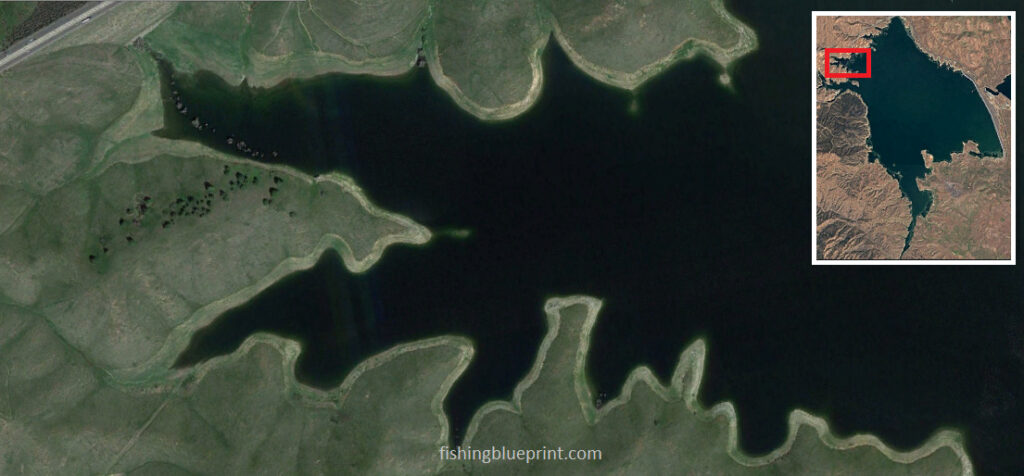
This smaller open bay was characterized by one primary creek channel with numerous smaller creek ditches and washes flowing into it. I found it especially productive to fish this bay during high water conditions and in the spring, as it offered many different structures to target and fish.
The main creek channels that drained from the bay to the main lake created underwater main lake points. This area has a ton of rocky high spots, ridges, humps, and ledges so be sure to find them with your fish finder.
Lastly, I discovered submerged trees and brush in the back of the feeder creeks in times of high water conditions. These spots turned out to be great places to fish as well.
Located: northwest lake
Structural features: creek channels, chunk rock bank submerged trees and brush
Best species to target: Striped bass, largemouth bass, catfish, crappie
Most effective way to fish this spot: boat, kayak, shore fishing
Cottonwood Creek

This section features a long rocky bank along the dike. The bank is characteristically very steep and made from large chunk rock to boulder-size substrate.
Naturally, crawfish, bluegill, minnows, and shad seek shelter in this area.
Given this embankment’s large area, it’s best to focus your efforts on cuts, points, boulder piles, and on transition areas from larger rock to smaller rock size.
Located: north end of the lake
Structural features: steep artificial rocky bank
Best species to target: Striped bass, largemouth bass, catfish, crappie
Most effective way to fish this spot: boat, kayak
San Luis Dam
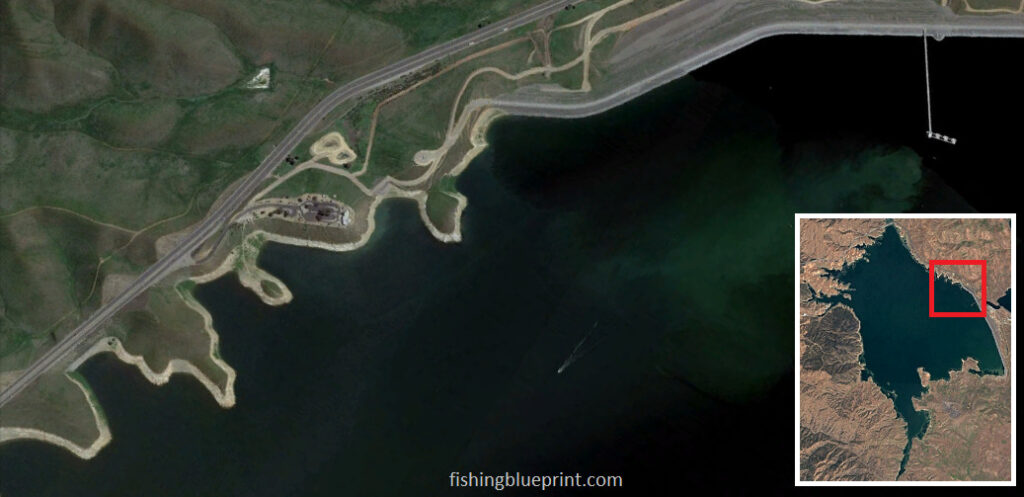
Fishing just along the dam and in front of Romero Overlook can be outstanding if you’re trolling for striped bass or trout.
If the water is low, graph the cove just to the north of the dam and you can find deep water humps that rarely get fished.
Look closer…

I can still picture fishing in this part of the lake where the wind would blow pretty hard. The wind might easily blow me away from my place even with the greatest trolling motor, greatly reducing my chances of catching fish. I therefore urge you to get a high-quality drift sock.
For those who don’t know, a drift sock functions similarly to a water-based parachute. Slowing down your drift is essential when it’s windy to breezy because otherwise, your lure won’t stay in the strike zone long enough to catch a fish. During those windy days on the lake, using a drift sock was crucial for me.
By the way, we found a really good quality drift sock made by Mythik Outdoors, and best of all they’re sold on Amazon.com. Go here to learn more about drift socks and read the reviews from actual customers.
Located: east lake
Structural features: steep rocky bank
Best species to target: Striped bass, trout, largemouth bass, catfish, crappie
Most effective way to fish this spot: boat, kayak, shoreline
Goosehead Point
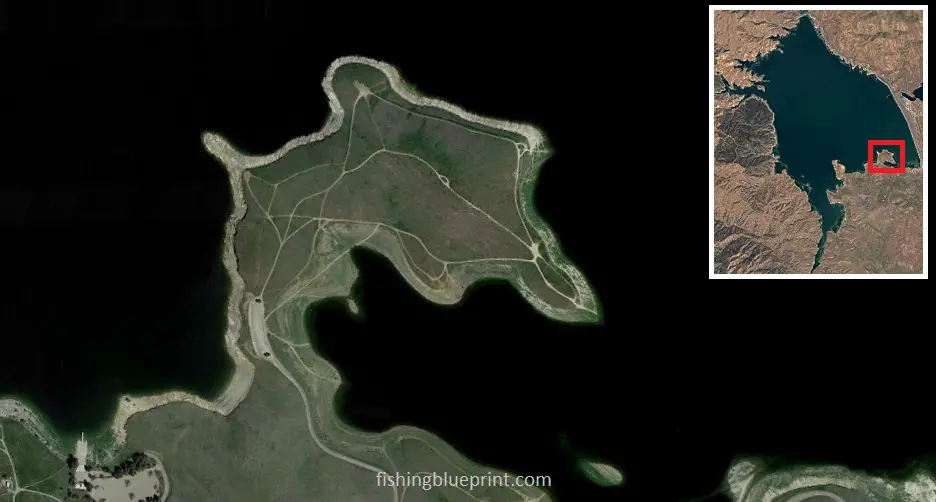
When I fished Goosehead Point, I focused on bass relating to the steep bank filled with chunk rock and boulder piles. I found that fishing the “transition areas”, or the area that turns from larger rock to smaller rock size, often caught me more bass.
Naturally, crawfish, bluegill, minnows, and shad sought shelter in this area.
Considering the large area of this embankment, I concentrated my efforts on cuts, points, boulder piles, and transition areas from larger rock to smaller rock size. It proved to be a successful strategy for catching bass at Goosehead Point.
Located: south east lake
Structural features: steep rocky bank and points
Best species to target: Striped bass, largemouth bass, catfish, crappie
Most effective way to fish this spot: boat, kayak, shoreline fishing
Willow Springs Bay
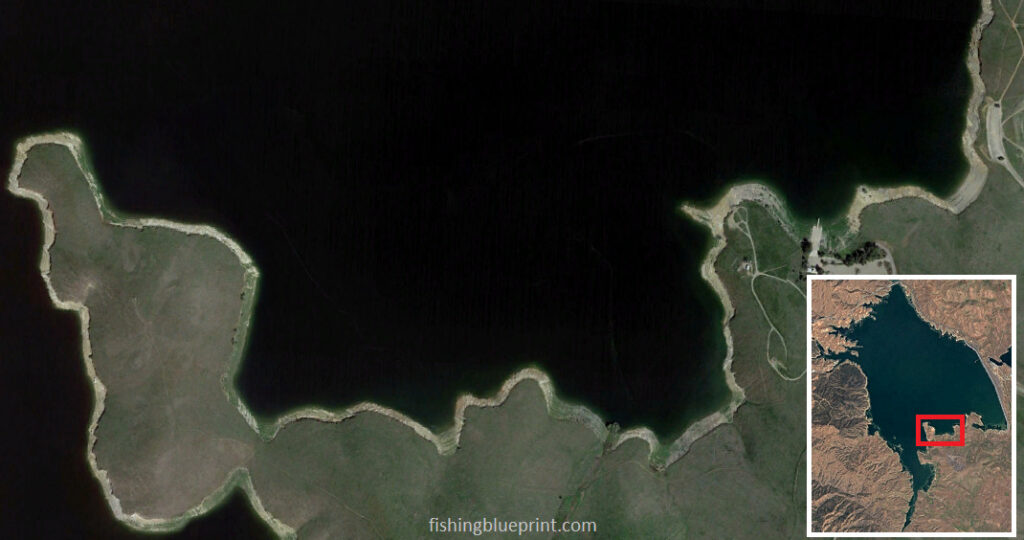
This spot is great because it’s a “structure flat” when the water is low.
The banks are fairly steep, down to 100-feet below normal pool level. After that it flattens out.
There are several rocky secondary points that attract bass. Furthermore, there is a single large ditch for this entire bay that attracts fish year around.
On the west side of Willow Springs Bay is the large main lake point called Quien Sabe Point. This point is excellent for summer bass fishing due to the channel swing running into the northwest tip of the point.
Located: South end of the lake
Structural features: rocky points, rocky shelves, solitary drainage ditch
Best species to target: Striped bass, largemouth bass, catfish, crappie
Most effective way to fish this spot: boat, kayak, shoreline fishing
Lone Oak Bay
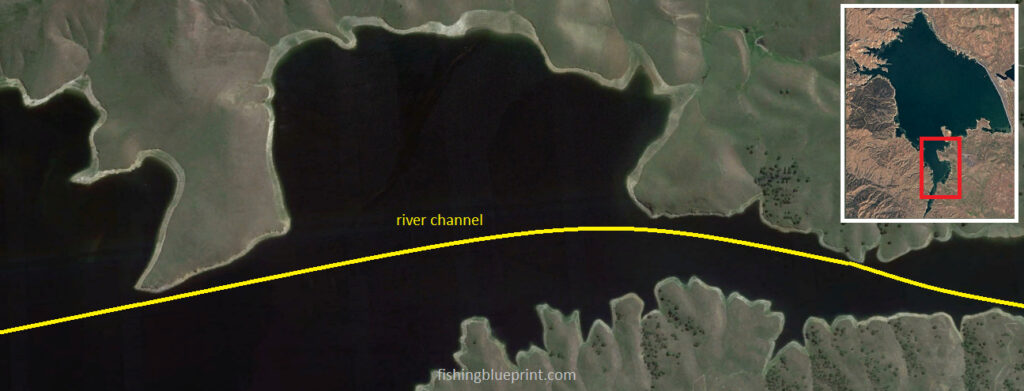
This spot is defined by a deep water channel swings into close proximity of the bank making it a great spot for both boat fisherman and as well as shoreline anglers.
The channel swings also create multiple ledges, ridges, drop offs and humps.
Before trying to fish everything, be sure to take some time and scan these areas first with your fish finder to see if there are any bait or bass relating to that particular spot. If you see bait or bass in the spot then fish it.
Located: southwest end of the lake
Structural features: channel swing into the bank, points, ledges, ridges, drop offs, and humps
Best species to target: Striped bass, largemouth bass, catfish, crappie
Most effective way to fish this spot: boat, kayak, shoreline fishing
Boat Ramps at San Luis Reservoir
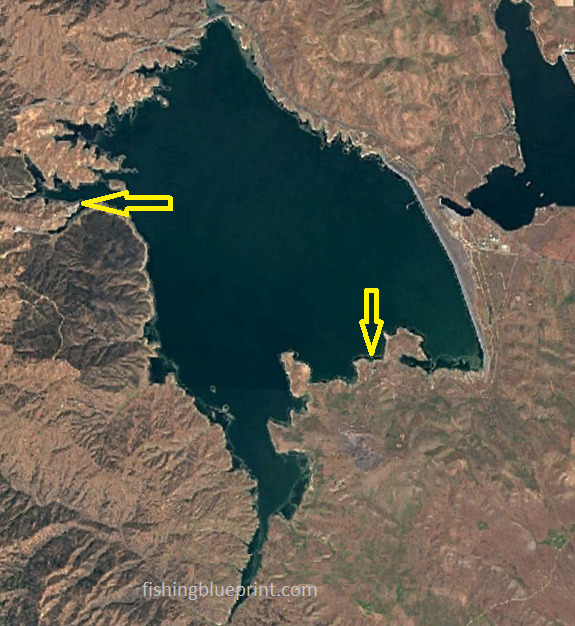
Dinosaur Point State Park Entrance Station
Location: northwest area of the lake
Dinosaur Point Rd, Hollister, CA 95023
(209) 826-1196
Lanes: 2
Restrooms: Yes
Showers: no
Gas: No
Camping nearby: Yes
San Luis Reservoir SRA
Location: south end of the lake
Address: 31426 Gonzaga Rd, Gustine, CA 95322
Phone: (209) 826-1196
(209) 826-1197
Lanes: 2
Restrooms: Yes
Showers: no
Gas: No
Camping nearby: Yes
Places to Tent Camp Or RV Camping At San Luis Reservoir
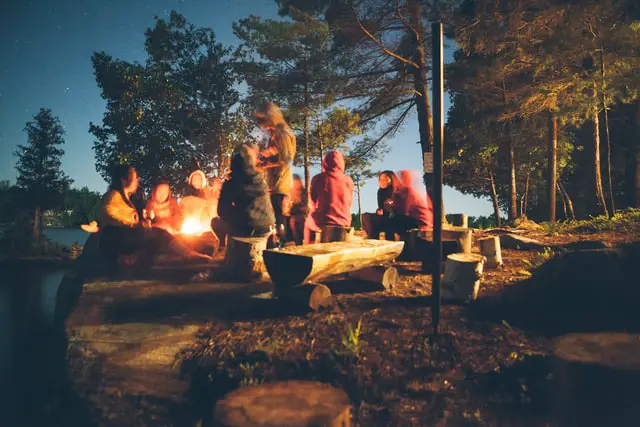
Traditional camping areas
Basalt Campground
Basalt Rd, Gustine, CA 95322
(209) 826-9709
Reservations and campground map
- Sites – 79total.
- RV – some have hook ups, some don’t
- Standard sites/ tent sites available
- Dump station available: Yes
- Low season: October – March
- High season: April – September
- Pets welcome: Yes
- Boat ramp nearby: Yes
- Fire ring: Yes
- Grill: Yes
- Drinking water: Yes
- Coin operated showers: Yes
- Flush toilets: Yes
- Coin operated showers: Yes
San Luis Creek Campground
Gustine, CA 95322
(209) 826-9709
Reservations and campground map
- Sites – 53 total.
- RV – some have hook ups, some don’t
- Standard sites/ tent sites available
- Dump station available: Yes
- Low season: October – March
- High season: April – September
- Pets welcome: Yes
- Boat ramp nearby: Yes
- Fire ring: Yes
- Grill: Yes
- Drinking water: Yes
- Coin operated showers: no
- Flush toilets: no
Medeiros Campground
Donohugh Rd W, Gustine, CA 95322
(209) 826-9709
Reservations and campground map
- Sites – primitive, first come – first served
- Standard sites/ tent sites only
- Dump station available: no
- Low season: October – March
- High season: April – September
- Pets welcome: Yes
- Boat ramp nearby: Yes
- Fire ring: Yes
- Grill: Yes
- Drinking water: Yes
- Coin operated showers: no
- Flush toilets: no
Los Banos Creek Campground
Los Banos, CA 93635
(209) 826-9709
Reservations and campground map
- Sites – 20 total.
- RV – small sites, very limited in availability.
- Standard sites/ tent sites available
- First come – first served
- Dump station available: no
- Low season: October – March
- High season: April – September
- Pets welcome: Yes
- Boat ramp nearby: Yes
- Fire ring: Yes
- Grill: Yes
- Drinking water: Yes
- Coin operated showers: no
- Flush toilets: no
Tackle Shops Near San Luis Reservoir
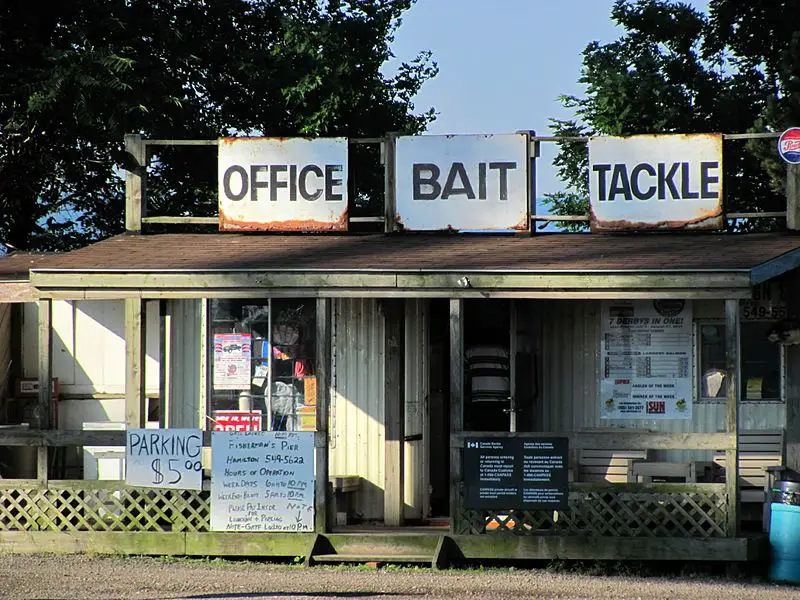
Main Street Market Live Bait and Tackle
13301 CA-33, Gustine, CA 95322
Located in: Santa Nella RV Park
Walmart Supercenter
1575 W Pacheco Blvd, Los Banos, CA 93635
(209) 826-9655
Other California Related Fishing Articles
- Bass Lake Fishing Report
- Clear Lake Fishing Report
- Castaic Lake Fishing Report
- California Delta Fishing Report
- Diamond Valley Lake Fishing Report
- Don Pedro Reservoir Fishing Report
- Eagle Lake Fishing Report
- El Capitan Reservoir Fishing Report
- Lake Berryessa Fishing Report
- Big Bear Lake Fishing Report
- Folsom Lake Fishing Report
- Irvine Lake Fishing Report
- Lake Almanor Fishing Report
- Lake Camanche Fishing Report
- Lake Isabella Fishing Report
- Lake Havasu Fishing Report
- Lake McClure Fishing Report
- Lake Oroville Fishing Report
- Lake Perris Fishing Report
- Lake Piru Fishing Report
- Lake Skinner Fishing Report
- Lake Tahoe Fishing Report
- Los Banos Reservoir Fishing Report
- New Hogan Lake Fishing Report
- New Melones Lake Fishing Report
- O’Neill Forebay Fishing Report
- Pardee Lake Fishing Report
- Pyramid Lake Fishing Report
- San Luis Reservoir Fishing Report
- San Vicente Reservoir Fishing Report
- Shasta Lake Fishing Report
- Silverwood Lake Fishing Report
- Trinity Lake Fishing Report
- Whiskeytown Lake Fishing Report
More articles just for you...
Funny Fishing Rules, Laws, and Regulations 2025
Crazy Fishing Laws That Will Blow Your Mind! #7 is INSANE! Strange Fishing Regulations and Laws As silly as hook and rod limits may seem,
EXPOSED! How To Use A Spinnerbait The Right Way for 2025
Are You Wondering How To Use A Spinnerbait? Or How To Work A Spinnerbait Over Grass, Logs, or Points? Well, All These Questions Are Answered
EXPOSED! Best Crankbait Colors for 2025 [Which to Buy & Avoid]
What color crankbait to use? Crankbait Color Chart I just love going into a Bass Pro Shops store and just staring at all the walls
Best Underwater Dock Lights For Fishing – 2025 Buyers Guide
Night Dock Light Fishing For Beginners Dear fellow angler, Does this sound like you? You’re someone who loves fishing but just wants to escape the
15 Best Deep Diving Crankbaits [2025 Buyers Guide – Which to Buy & Avoid]
A Complete Buyer’s Blueprint On The Best Deep Diving Crankbaits for Bass, Walleye, or Striped Bass On The Market Today Fishing deep diving crankbaits can

